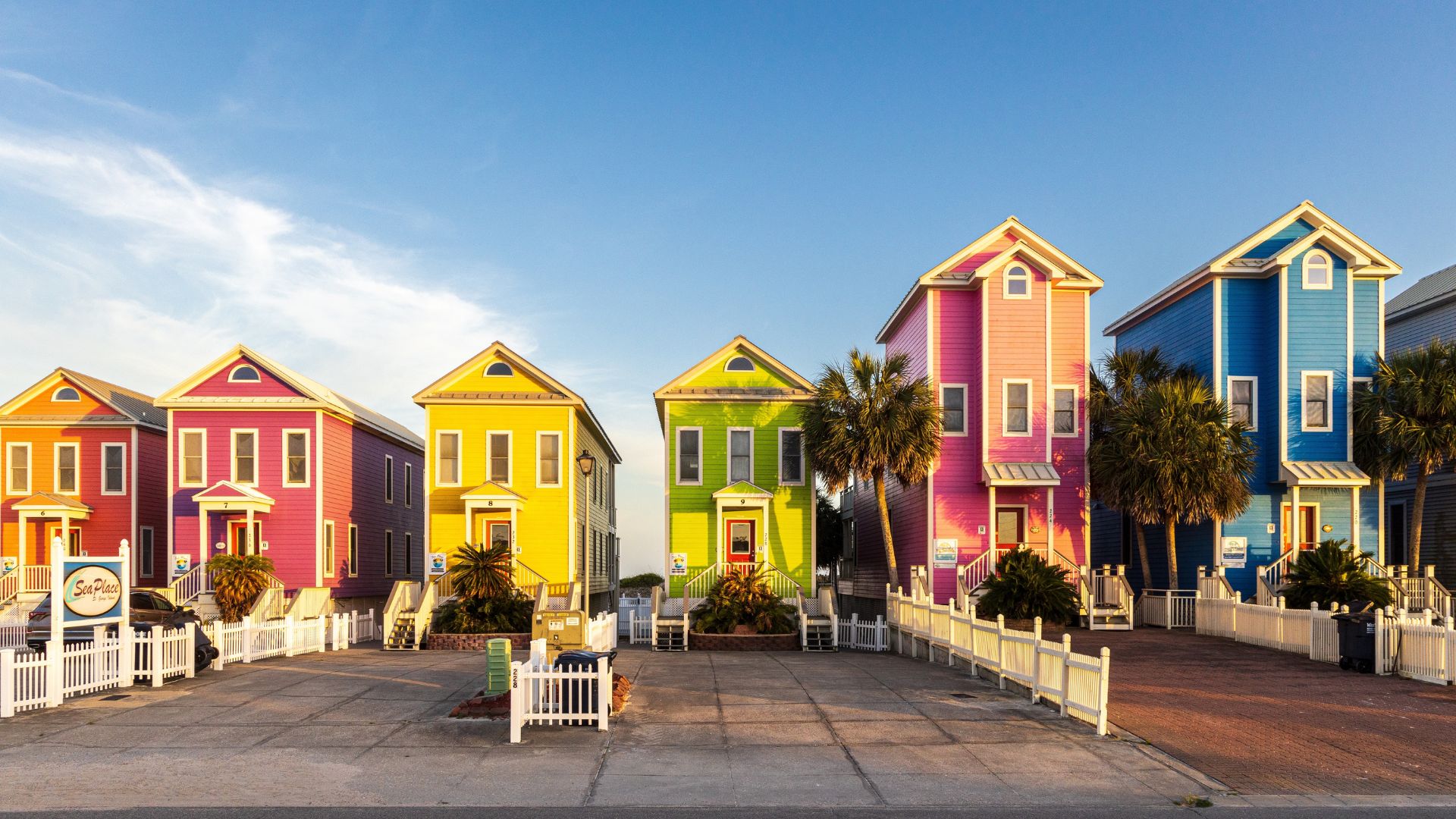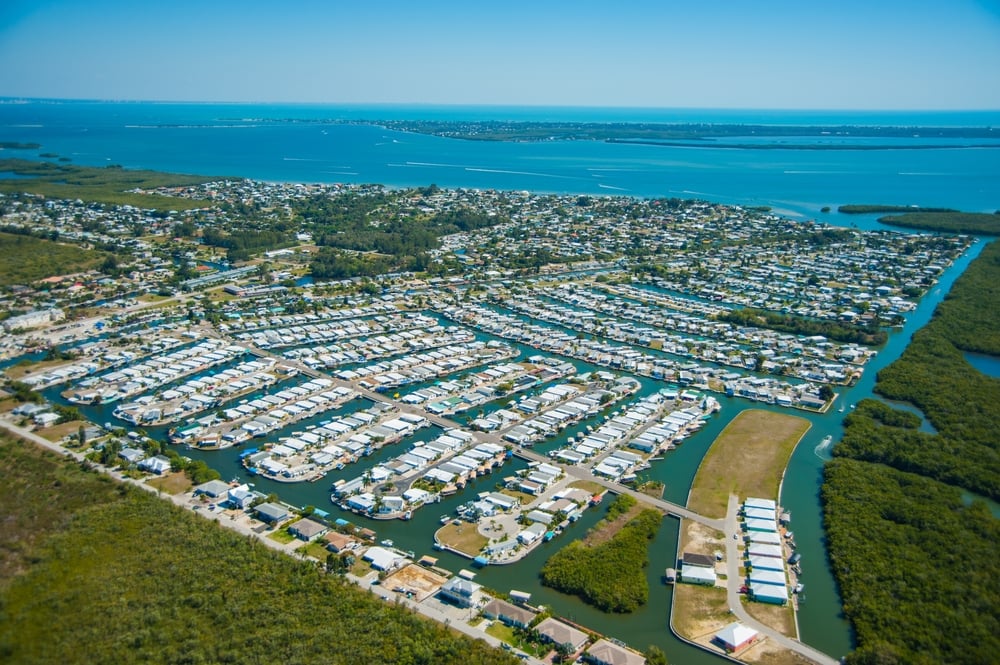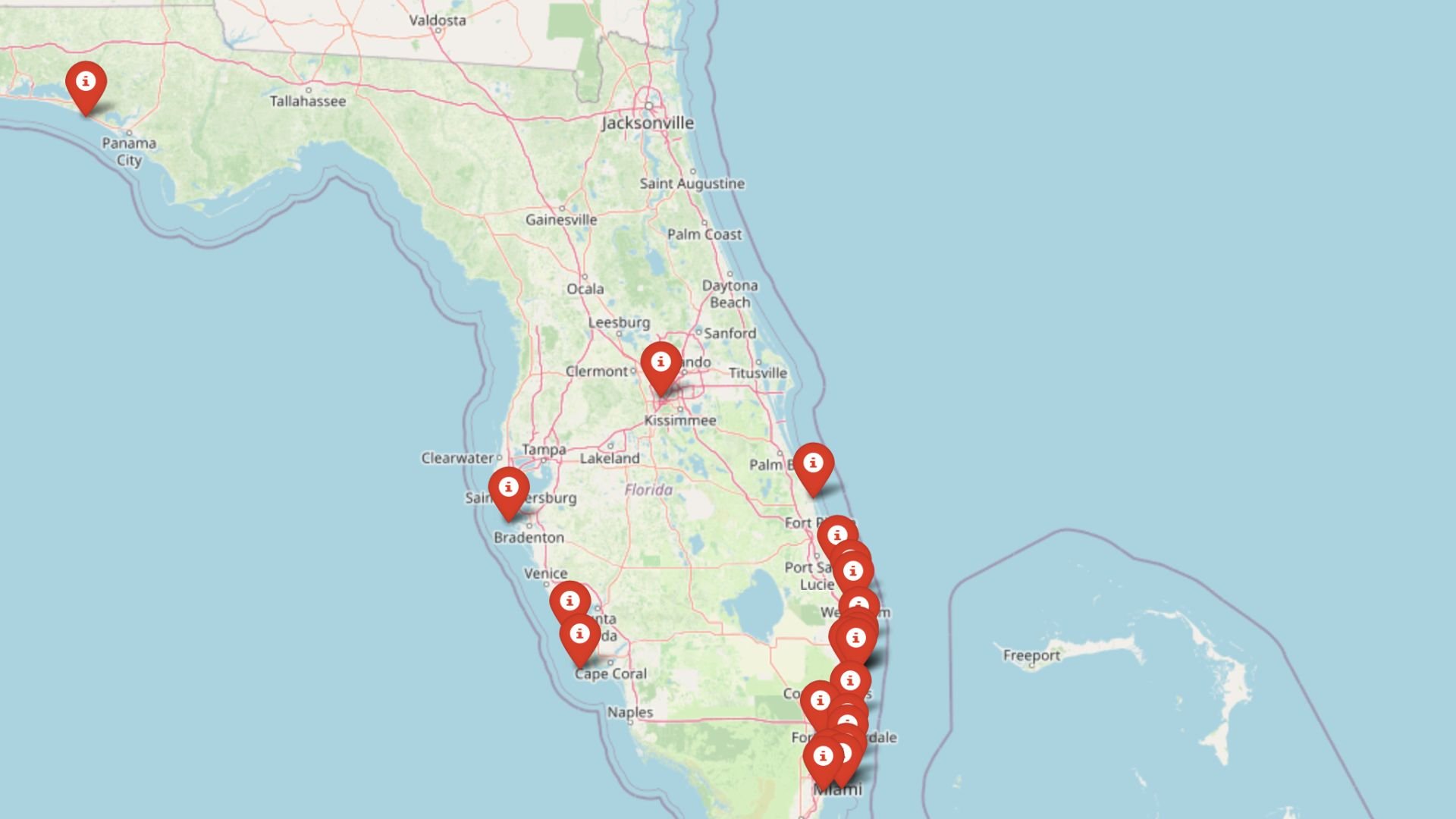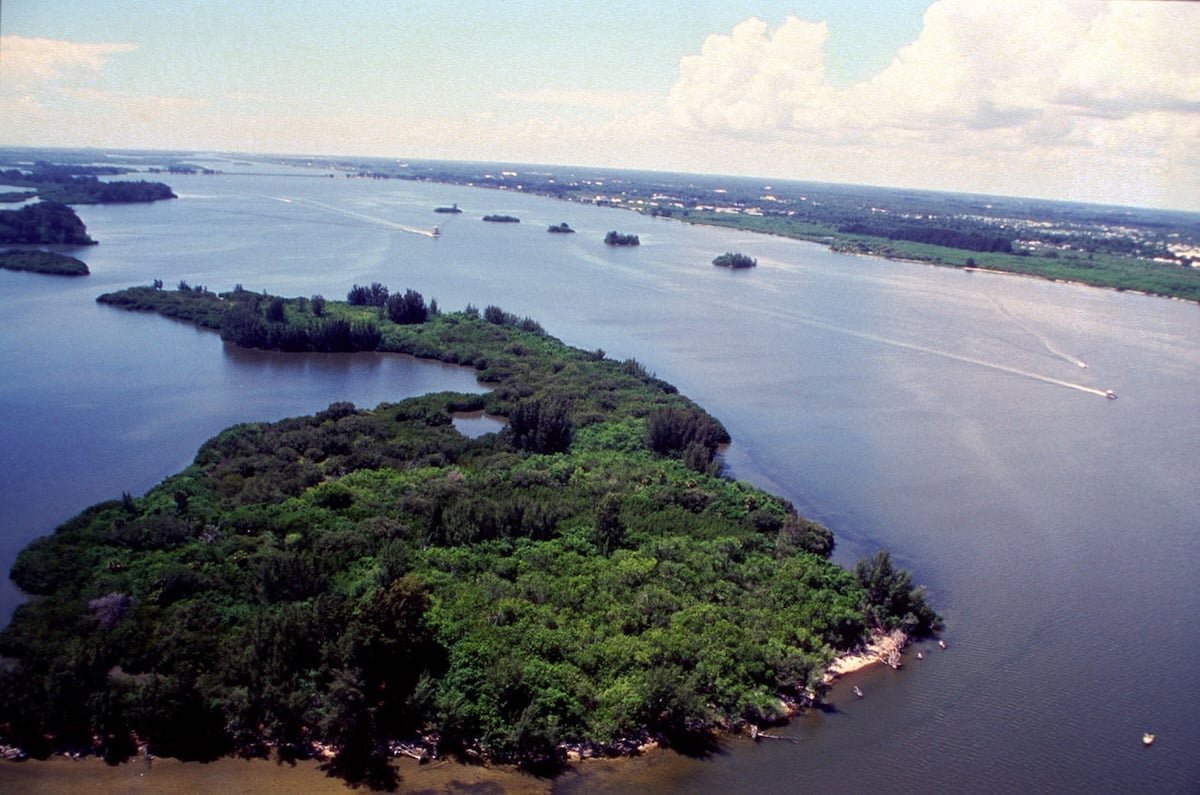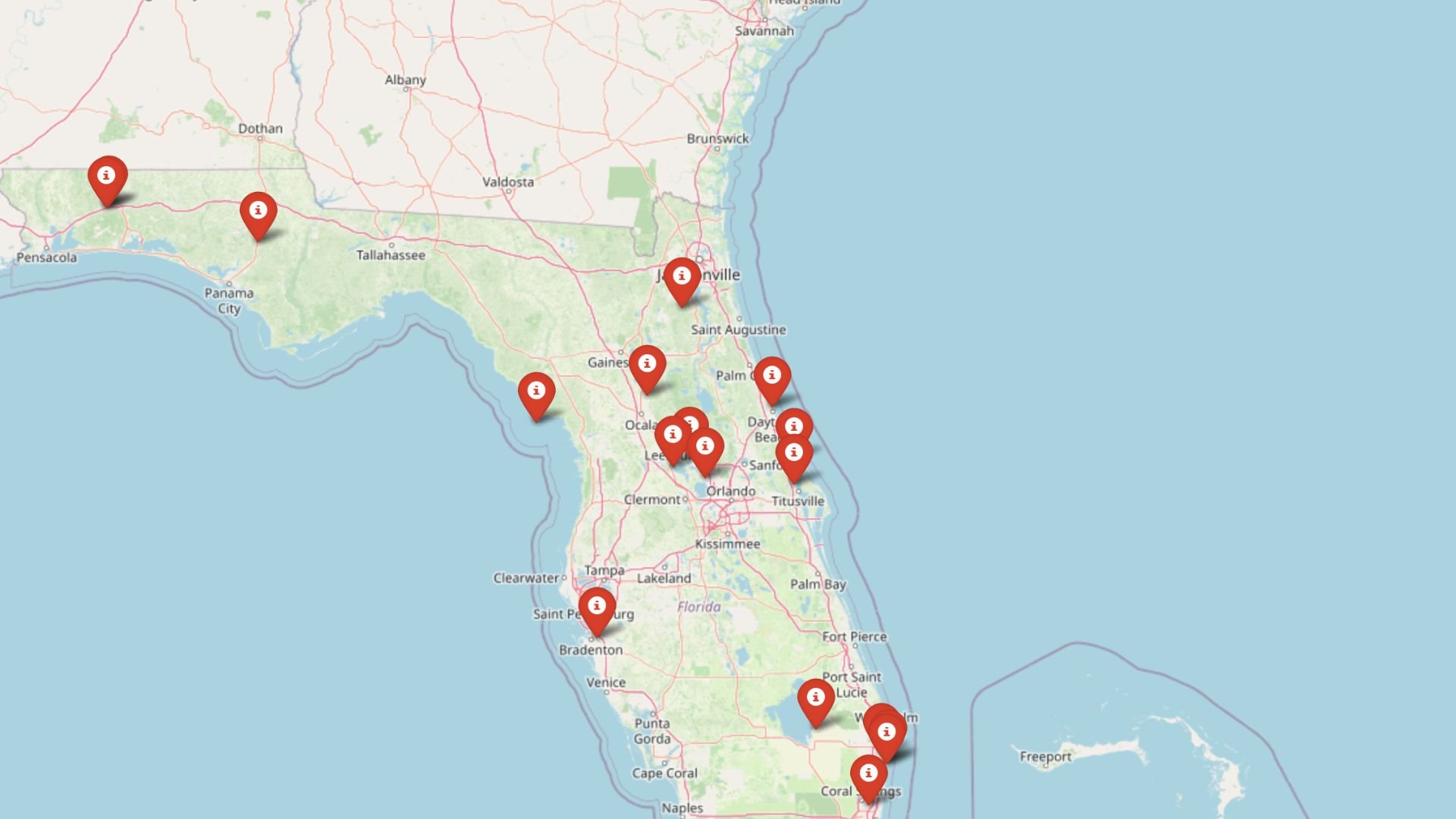
Counties with the shortest life expectancy in Florida
Life expectancy can be affected by a variety of factors. About 25% of your lifespan is determined by genetics, according to the National Library of Medicine. Health and wellness habits—like following a balanced, nutrient-rich diet; not smoking; drinking minimal alcohol; maintaining a healthy weight; and staying physically active—can add more than a decade to your life, research from the National Institutes of Health shows. While these factors are significant, another important element that you might not have considered is your environment and community.
While life expectancy generally increases annually in the United States—jumping from about 70.8 years old to 77.5 between 1970 and 2022, according to the Centers for Disease Control and Prevention—this particular metric can vary from state to state or even county to county. In some parts of the country, the average lifespan is getting shorter based on a variety of risk factors on top of health, including socioeconomic factors like poverty, unemployment, income, and education.
According to a 2020 study from researchers at Penn State, West Virginia, and Michigan State Universities, communities with a higher population density, more fast food restaurants, and a high number of extraction industry-based jobs tend to have shorter life expectancies.
To find out how life expectancy varies within Florida, Stacker used 2024 County Health Rankings & Roadmaps from the University of Wisconsin Population Health Institute to identify the counties with the shortest life expectancy. Life expectancy measures the average number of years from birth a person can expect to live and is calculated based on the number of deaths in a given time period and the average number of people at risk of dying during that period. Counties with unreliable or insufficient data were excluded from the analysis. Mortality data came from the National Vital Statistics System.
Read on to see if your county is on the list.
You may also like: Airports using biometric facial recognition in Florida

#33. Gilchrist County (tie)
– Life expectancy: 75.6 years
— 2.9 years lower than the state average

About
Gilchrist County carries a rural character defined by rivers, springs, and stretches of farmland that have long shaped its identity. The Suwannee and Santa Fe Rivers outline much of the landscape, offering both natural beauty and resources that sustain the community. Small towns and family farms remain central, where schools, churches, and local institutions tie neighbors together.
Community gatherings, seasonal events, and outdoor traditions strengthen bonds and highlight the county’s heritage. Life here reflects resilience, simplicity, and connection to land and water, where residents value both their history and the quiet pace that continues to define the area.
Where is Gilchrist County?
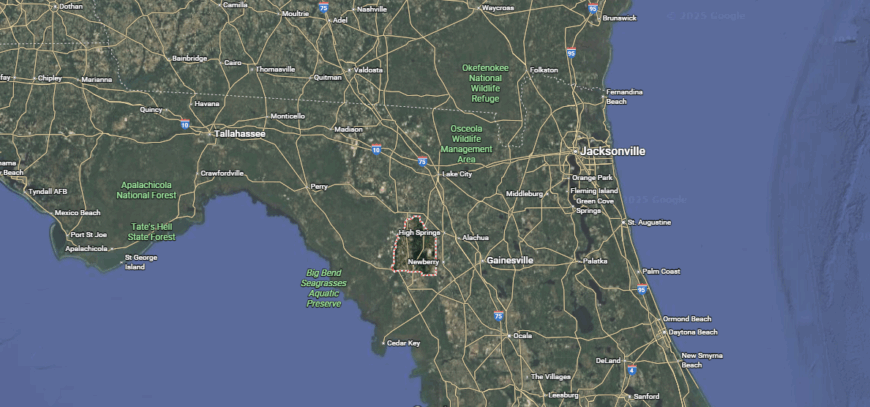
Gilchrist County is located in north-central Florida, bordered by the Suwannee River to the west and the Santa Fe River to the north. It lies about 30 miles west of Gainesville and is among the smallest counties in the state by land area.
Trenton serves as the county seat and largest city, situated near the center of the county. Bell is another notable town, located roughly 10 miles northwest of Trenton. Gilchrist County is largely rural, known for its agriculture, riverfront springs, and access to outdoor recreation along the Suwannee and Santa Fe Rivers.
#33. Hardee County (tie)
– Life expectancy: 75.6 years
— 2.9 years lower than the state average

About
Hardee County reflects the rhythms of a place where agriculture has long been the backbone of daily life. Vast citrus groves, cattle pastures, and open spaces shape both the landscape and the economy, tying the county’s identity to the land. Small communities anchor the area, where neighbors know one another and traditions pass easily from one generation to the next.
Local fairs, festivals, and gatherings highlight the pride residents take in their shared heritage. With its quiet setting and strong sense of continuity, Hardee County embodies a way of life built on hard work, connection, and respect for its rural roots.
Where is Hardee County?
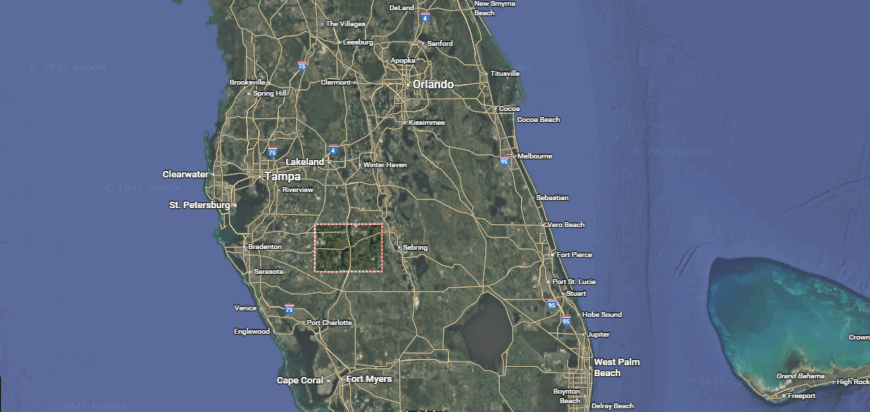
Hardee County sits in south-central Florida, positioned between Polk County to the north and DeSoto County to the south. It covers just over 600 square miles, with much of the land devoted to agriculture and open flatlands.
The county seat, Wauchula, lies near the center and is the primary hub for government and commerce. Bowling Green is located about 8 miles to the north, while Zolfo Springs lies a short distance southeast of Wauchula. Hardee County is widely recognized for its citrus groves, cattle ranches, and phosphate mining, all of which shape its economy and rural character.
#32. Highlands County
– Life expectancy: 75.5 years
— 3.0 years lower than the state average

About
Highlands County grew around its connection to the land, where citrus groves, cattle ranges, and fertile soil shaped both settlement and economy. The county seat of Sebring, founded in the early 20th century, reflects this balance of progress and tradition, while surrounding towns maintain a quieter pace tied to local roots.
Lakes scattered across the region draw people outdoors, whether for fishing, boating, or family gatherings along the shore. With a mix of agriculture, recreation, and small-town culture, Highlands County continues to move forward while holding close to the values that built it.
Where is Highlands County?

Highlands County is located in the heart of south-central Florida, stretching across the Lake Wales Ridge and surrounded by a mix of lakes, flatlands, and rolling sandhills. It sits about 85 miles south of Orlando and 95 miles east of Tampa, giving it a central position within the peninsula.
Sebring, the county seat, is positioned near the middle of the county and is known for its historic downtown and international raceway. Avon Park lies about 10 miles to the north, while Lake Placid is located roughly 15 miles to the south. Highlands County is distinguished by its chain of lakes, citrus production, and access to recreational areas like Highlands Hammock State Park.
#31. Hendry County (tie)
– Life expectancy: 75.4 years
— 3.1 years lower than the state average

About
Hendry County developed along the southern edge of Lake Okeechobee, where sugarcane fields and wide agricultural tracts have long defined its economy. Clewiston and LaBelle, its two main towns, reflect different aspects of this heritage—one tied to large-scale industry, the other to small-town civic life.
The area also carries strong cultural influences, with traditions rooted in farming, ranching, and the rhythms of the Everglades nearby. Residents value their ties to the land while maintaining a community spirit shaped by both resilience and shared history.
Where is Hendry County?
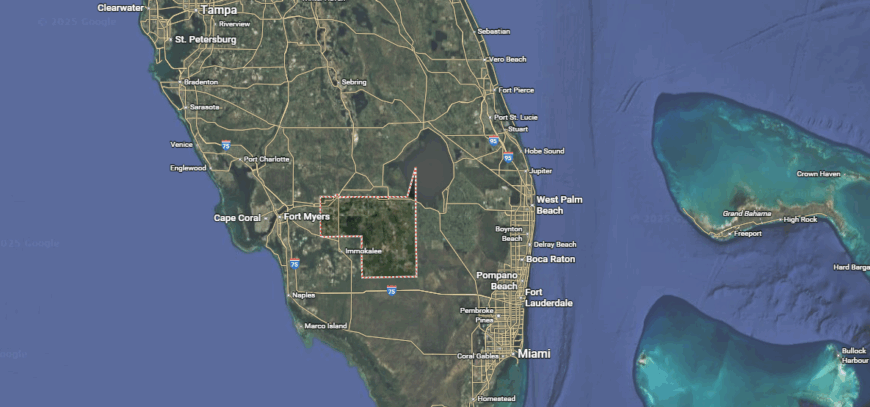
Hendry County is anchored by two key communities: Clewiston on the southern edge of Lake Okeechobee and LaBelle along the Caloosahatchee River. These towns form the county’s main centers of activity, connected by stretches of farmland and open landscape.
Covering more than a thousand square miles, Hendry sits between the lake and the northern reaches of the Everglades. Its identity is closely tied to sugarcane and other agricultural production, while the waterways provide both irrigation and recreation.
#30. Jefferson County (tie)
– Life expectancy: 75.4 years
— 3.1 years lower than the state average
You may also like: Best counties to raise a family in Florida

About
Jefferson County, one of Florida’s oldest, holds a history deeply woven into its small-town centers and agricultural lands. Monticello, the county seat, is noted for its preserved historic buildings and courthouse square, reflecting a legacy of civic pride that continues today.
Surrounded by forests, farms, and rolling countryside, the county balances heritage with a steady pace of rural living. Community traditions, local markets, and family gatherings sustain a culture where history and neighborly ties remain at the heart of daily life.
Where is Jefferson County?

Jefferson County occupies Florida’s eastern Panhandle, bordered by Georgia to the north and the Gulf of Mexico to the south. Unlike many other Florida counties, it stretches from coast to state line, giving it both inland farmland and coastal wetlands.
Monticello, the county seat, is a small historic town set near the center, surrounded by rolling hills and pecan groves. Smaller communities such as Wacissa and Lamont sit closer to the rivers and natural springs. With its mix of agriculture, timber, and preserved landscapes, Jefferson County maintains a quiet, rural character while lying just 25 miles east of Tallahassee.
#29. Volusia County
– Life expectancy: 75.3 years
— 3.2 years lower than the state average

About
Volusia County stretches from the Atlantic shoreline to inland rivers and forests, creating a setting where coastal energy meets quiet natural spaces. Daytona Beach anchors the coast with its world-famous speedway and boardwalk, while inland towns highlight a different character tied to springs, rivers, and oak canopies.
Tourism, education, and outdoor recreation shape the county’s identity, supported by a mix of long-standing traditions and modern growth. Whether on the oceanfront, along the St. Johns River, or in historic downtowns, Volusia County reflects both motion and memory in equal measure.
Where is Volusia County?
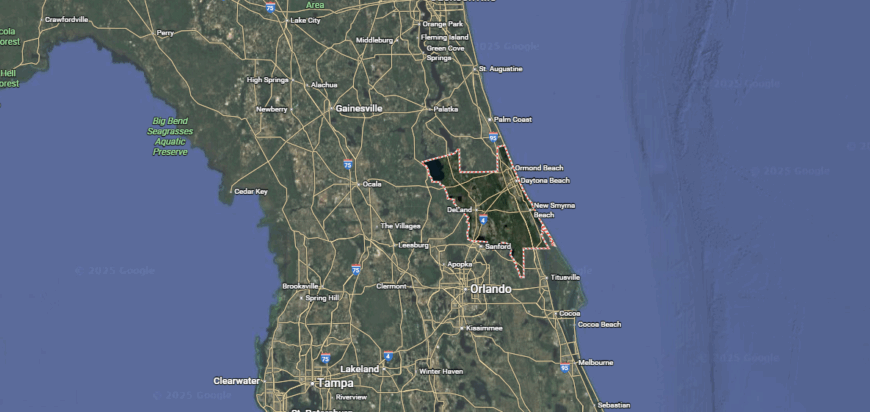
Volusia County sits along Florida’s Atlantic Coast, extending from the sandy beaches of Daytona Beach to the inland forests and waterways near the St. Johns River. It covers more than 1,200 square miles, creating a diverse landscape that blends coastal living with rural interior stretches.
Daytona Beach serves as the most recognized city, famous for its motorsports and oceanfront. DeLand, the county seat, lies further inland and is home to Stetson University, while New Smyrna Beach and Ormond Beach add to the county’s shoreline communities. Tourism, higher education, and a growing residential base shape Volusia’s economy, making it one of the state’s most dynamic regions.
#28. Hernando County
– Life expectancy: 75.0 years
— 3.5 years lower than the state average

About
Hernando County, set along Florida’s Nature Coast, is framed by a mix of Gulf waters, rolling hills, and pine forests that give it a distinct identity. Brooksville, the county seat, showcases historic roots with preserved architecture, while coastal areas like Weeki Wachee connect the region to springs and waterways.
The economy draws from both agriculture and tourism, with farming traditions standing alongside outdoor attractions that bring visitors year-round. Residents value the balance of heritage, natural beauty, and steady community life that continues to define Hernando County.
Where is Hernando County?

Hernando County is often called the gateway to Florida’s Nature Coast, where clear springs and riverways meet wide stretches of oak hammocks and pastureland. The Gulf shoreline is dotted with marshes and small fishing communities, while inland terrain rises into some of the state’s few rolling hills.
Brooksville anchors the county with historic streets and government offices, while Spring Hill has grown into the main suburban center. Weeki Wachee Springs, famous for its mermaid shows and natural beauty, is one of Hernando’s best-known destinations, and agriculture still provides much of its rural backbone.
#27. Wakulla County
– Life expectancy: 74.9 years
— 3.6 years lower than the state average

About
Wakulla County is closely tied to its coastal setting and the vast protected lands of the Apalachicola National Forest and St. Marks National Wildlife Refuge. Its landscape of marshes, rivers, and Gulf shoreline has shaped both livelihood and culture, from early fishing communities to modern conservation efforts.
Life here centers on connection to nature, where outdoor traditions like boating, scalloping, and hiking remain part of daily rhythms. With small towns and tight-knit neighborhoods, Wakulla County blends natural richness with a strong sense of community belonging.
Where is Wakulla County?
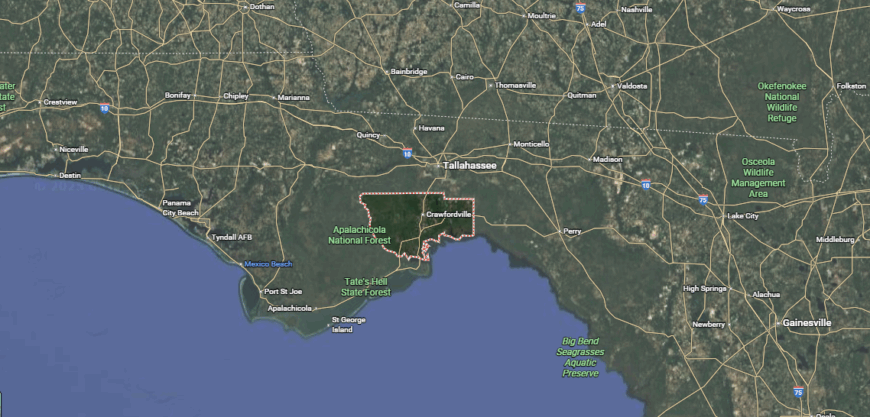
Wakulla County sits just south of Tallahassee, where the Panhandle gives way to salt marshes, pine flatwoods, and the Gulf of Mexico. Unlike many counties, it is more defined by its natural preserves than its urban areas, with large portions of land held as state parks, forests, and wildlife refuges.
Crawfordville functions as the county seat, but the area is better known for landmarks like Wakulla Springs, one of the world’s largest freshwater springs, and the St. Marks National Wildlife Refuge along the coast. Fishing villages, rivers, and quiet forests give Wakulla a balance of coastal heritage and ecological richness, making it a rare blend of wilderness and small-town living.
#26. Franklin County
– Life expectancy: 74.8 years
— 3.7 years lower than the state average

About
Franklin County lies along the Gulf Coast, where small fishing towns and barrier islands define much of its character. Apalachicola, the historic county seat, is renowned for its maritime heritage and oyster industry, while coastal communities and beaches reflect a slower pace tied to the water.
The area thrives on traditions of fishing, boating, and trade, supported by a culture that values both independence and close community ties. With its blend of history, working waterfronts, and natural beauty, Franklin County remains rooted in the rhythms of the coast.
Where is Franklin County?
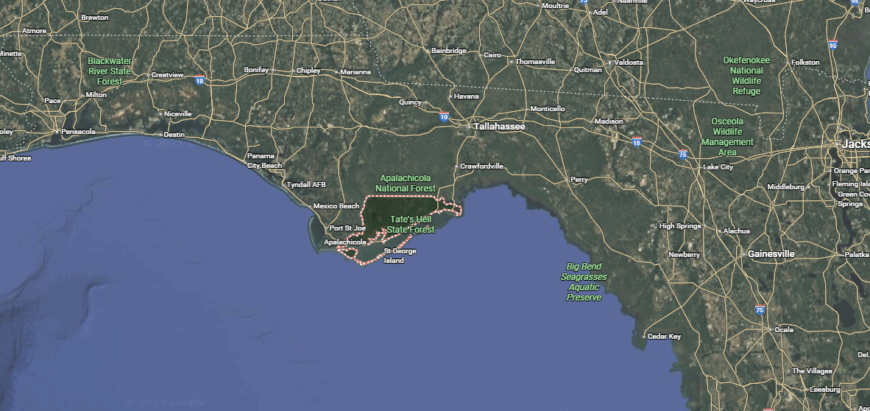
Apalachicola anchors Franklin County, a historic port town that once served as a major cotton-shipping hub and today is tied to seafood and maritime culture. Smaller communities like Carrabelle and Eastpoint spread along the coast, each shaped by fishing and access to the Gulf.
The county itself is narrow, with the Gulf of Mexico on one side and Apalachicola National Forest just inland. Its barrier islands, including St. George Island, provide beaches and wildlife habitats, making Franklin a place where working waterfronts and preserved landscapes stand side by side.
#25. Bradford County (tie)
– Life expectancy: 74.6 years
— 3.9 years lower than the state average
You may also like: Metros where renters are the most overextended in Florida

About
Bradford County, situated in north-central Florida, has long been anchored by its role as a hub for farming, forestry, and small-town life. Starke, the county seat, reflects this history with a downtown that serves as both a civic and cultural center for the surrounding communities.
The county’s identity is tied to tradition—family farms, schools, and churches remain central to daily rhythms. With a steady pace and close-knit ties, Bradford County continues to embody the values of resilience and community connection that have shaped it for generations.
Where is Bradford County?
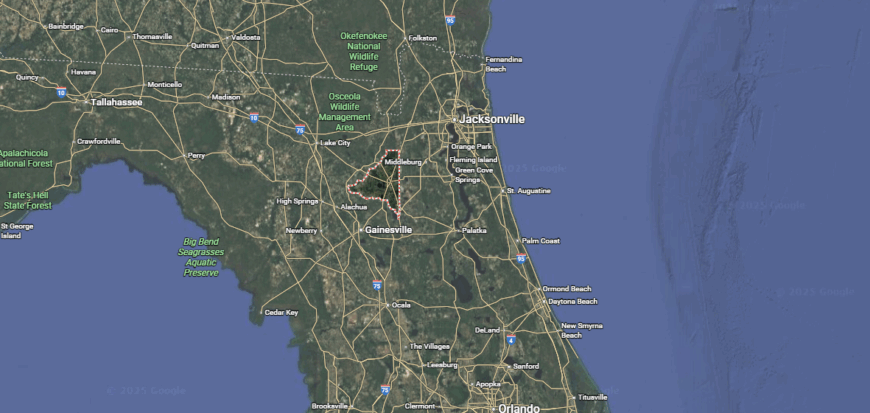
Bradford County is centered around Starke, the county seat, which grew along the old railroad lines that once connected northern Florida. The town remains the focal point for government, schools, and commerce, with smaller rural communities spread outward into farmland and pine forests.
Covering just under 300 square miles, it is one of Florida’s smaller counties by size. Positioned about 45 miles southwest of Jacksonville and 30 miles northeast of Gainesville, Bradford sits between major regional hubs while keeping a rural identity rooted in forestry, agriculture, and correctional institutions.
#24. Lafayette County (tie)
– Life expectancy: 74.6 years
— 3.9 years lower than the state average

About
Lafayette County, one of Florida’s smallest by population, is defined by its quiet stretches of farmland, pine woods, and the Suwannee River along its edge. Mayo, the county seat, stands at the center of civic life, reflecting the county’s history and its continuing role as a close community hub.
Generations of farming families, local schools, and shared traditions sustain a way of life that emphasizes simplicity and connection. With its rural pace and strong ties to the land, Lafayette County remains a place where community and heritage guide everyday living.
Where is Lafayette County?
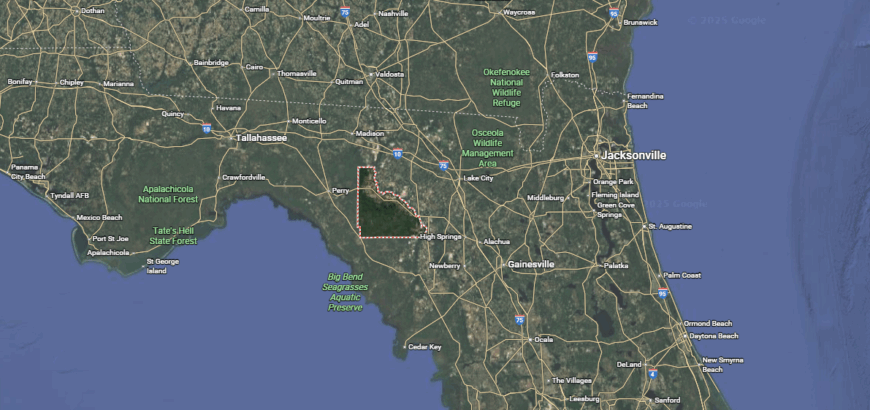
Lafayette County is one of Florida’s smallest by population, with Mayo as both the county seat and its only incorporated town. Life here revolves around a single main street, where local government, schools, and small businesses sit close together.
The Suwannee River forms much of the county’s boundary, and pine forests and farmland make up the interior. Set in north-central Florida, Lafayette is surrounded by larger counties but keeps a quiet, close-knit character shaped by timber, agriculture, and riverfront recreation.
#23. Bay County
– Life expectancy: 74.5 years
— 4.0 years lower than the state average

About
Bay County sits on Florida’s Panhandle coastline, where the Gulf of Mexico shapes both its economy and daily life. Panama City and Panama City Beach anchor the area, combining maritime industries with a steady flow of tourism drawn to sandy shores and emerald waters.
Beyond the beaches, the county includes military installations, thriving small towns, and natural spaces that highlight its diverse character. With a blend of coastal energy, service traditions, and local pride, Bay County continues to balance growth with its deep connection to the Gulf.
Where is Bay County?
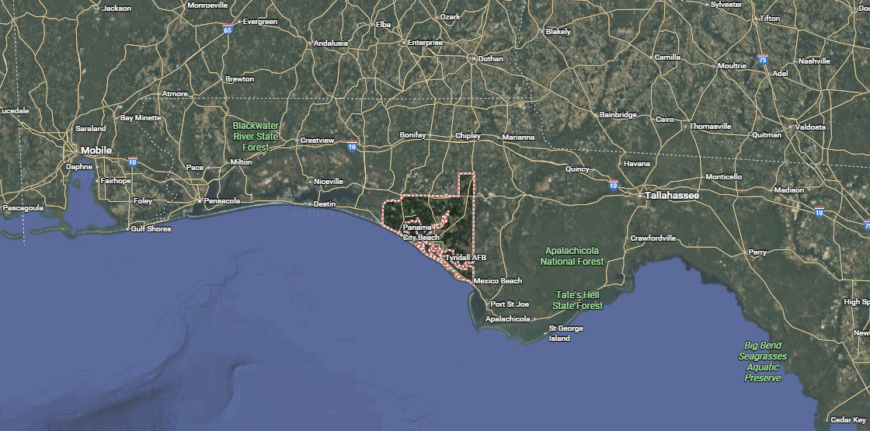
Bay County takes its name from St. Andrews Bay, the large inlet that defines its center and connects directly to the Gulf of Mexico. Much of the county’s identity is tied to its waterfront, from beaches and fishing piers to naval and industrial use of the bay itself.
Panama City serves as the county seat and largest city, while Panama City Beach, Lynn Haven, and Callaway make up other major communities. The county spans about 760 square miles in Florida’s Panhandle, balancing tourism on its white-sand coast with military installations and a strong maritime economy.
#22. Marion County (tie)
– Life expectancy: 74.4 years
— 4.1 years lower than the state average

About
Marion County, set in the heart of central Florida, is widely recognized for its rolling pastures and reputation as the “Horse Capital of the World.” Ocala, the county seat, reflects this identity through its equestrian culture, historic districts, and growing commercial centers.
The area balances agriculture with outdoor recreation, supported by springs, forests, and trails that invite year-round activity. With strong ties to land and tradition, Marion County continues to represent a blend of rural heritage, community pride, and steady growth.
Where is Marion County?
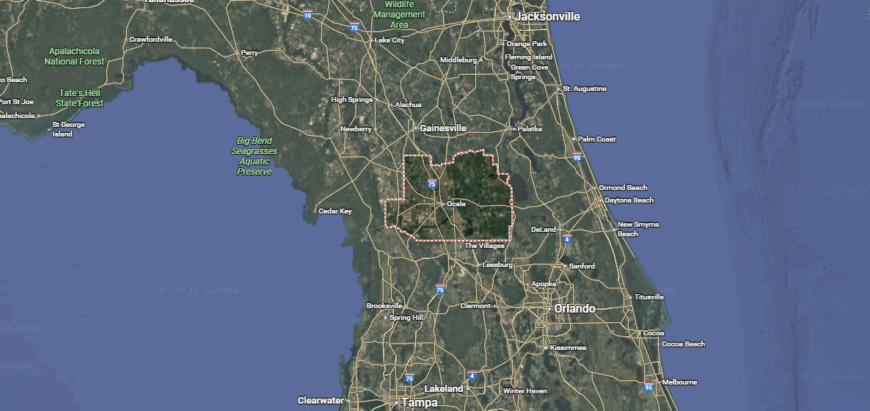
Marion County is often referred to as Florida’s horse country, with rolling pastures and thoroughbred farms stretching across much of its interior. Ocala, the county seat, anchors the region and has grown into a hub for equestrian events, healthcare, and commerce.
The county covers over 1,600 square miles in north-central Florida, placing it among the state’s largest. Alongside its agricultural reputation, Marion is home to Silver Springs, one of Florida’s earliest tourist destinations, and a variety of state parks and forests that highlight its mix of farmland and natural springs.
#21. Baker County (tie)
– Life expectancy: 74.4 years
— 4.1 years lower than the state average

About
Baker County, located in northeast Florida, carries a history tied to forestry, farming, and its position along early trade routes. Macclenny, the county seat, serves as the center of local life, combining small-town character with civic institutions that anchor the community.
Surrounded by pine forests and open land, the county maintains a lifestyle shaped by resilience and connection to its natural setting. Family traditions, schools, and community gatherings keep Baker County rooted in a strong sense of place and continuity.
Where is Baker County?
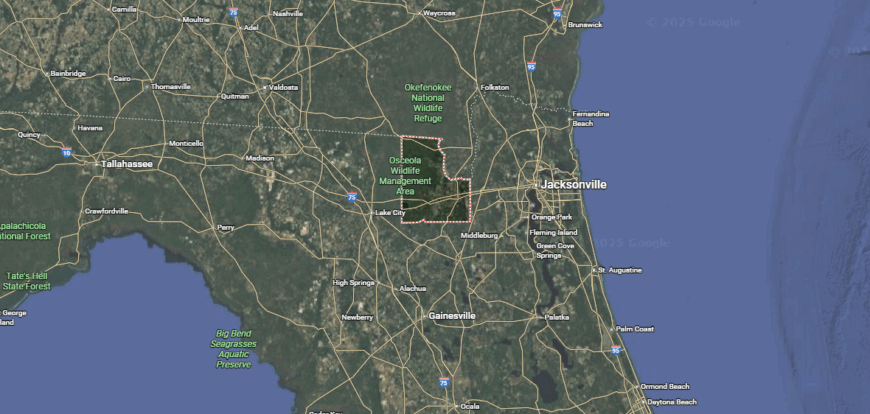
Baker County is rooted in the pine forests and flatwoods of northeast Florida, where timber and forestry have long shaped local life. The county spans just under 600 square miles and serves as a gateway between Jacksonville to the east and the rural stretches of Georgia to the north.
Macclenny, the county seat, is the center of activity, while Glen St. Mary and other smaller communities sit nearby along U.S. Highway 90. Osceola National Forest covers much of the western half of the county, giving Baker a strong tie to conservation lands and outdoor recreation alongside its rural and small-town character.
#20. Calhoun County (tie)
– Life expectancy: 74.3 years
— 4.2 years lower than the state average
You may also like: Where refugees in Florida are arriving from

About
Calhoun County, nestled in the Florida Panhandle, is defined by its deep roots in farming, forestry, and a tradition of self-reliance. Blountstown, the county seat, reflects this history with its courthouse square, local schools, and long-standing community gatherings.
Bordered by the Apalachicola River, the county’s landscape provides both natural resources and outdoor recreation that shape daily life. With a heritage of hard work and close connection to land and water, Calhoun County continues to embody the character of a rural Florida community.
Where is Calhoun County?
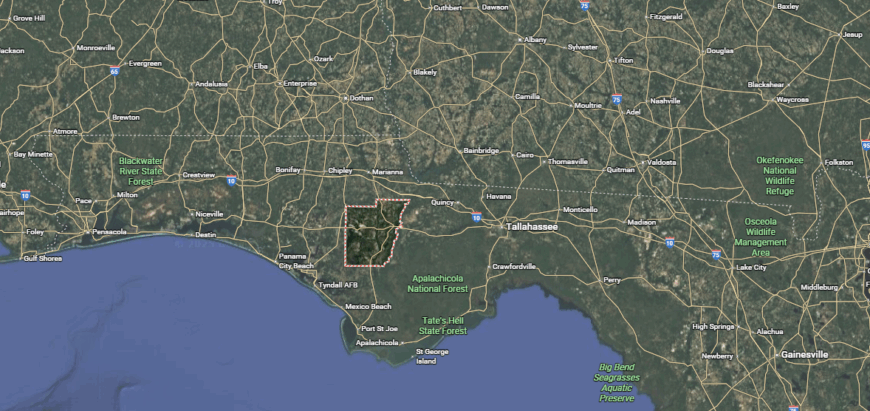
Calhoun County is a small, landlocked county in Florida’s Panhandle, where farmland and pine forest dominate the landscape. It covers just over 570 square miles, with the Apalachicola River forming much of its western boundary.
Blountstown, the county seat, sits along the river and serves as the main center of commerce and government. Altha, a smaller town to the north, reflects the county’s agricultural roots. With limited urban development, Calhoun is defined by farming, forestry, and access to river-based recreation.
#19. Duval County (tie)
– Life expectancy: 74.3 years
— 4.2 years lower than the state average

About
Duval County anchors northeast Florida as both an economic and cultural hub, centered around the city of Jacksonville. The St. Johns River runs through the county, tying together a landscape that blends urban development, port activity, and stretches of coastal shoreline.
As a consolidated city-county, Duval reflects both the pace of a major metropolitan area and the traditions of long-standing neighborhoods. Industry, military presence, and a strong cultural scene shape its identity, while residents maintain community ties that balance growth with heritage.
Where is Duval County?
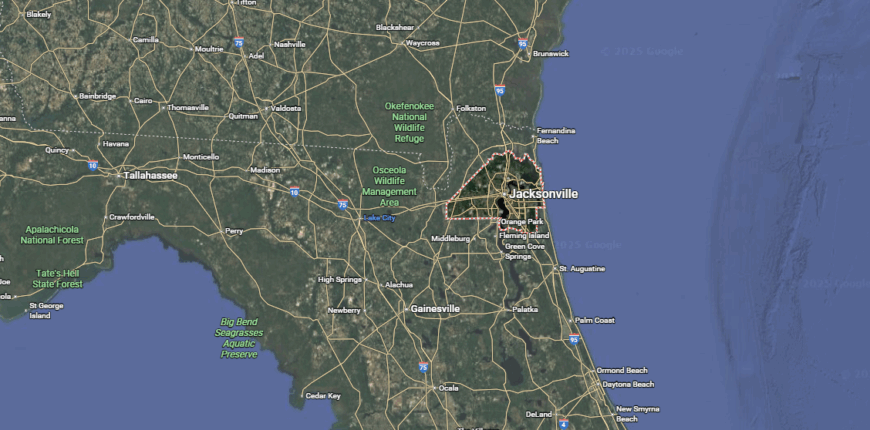
Duval County stands out in Florida because its government is consolidated with the City of Jacksonville, making it both a county and a city in function. This merger created one of the largest cities by area in the United States, stretching from the Atlantic coastline inland to the St. Johns River and beyond.
The county encompasses a mix of urban neighborhoods, military bases, port facilities, and barrier island communities like Jacksonville Beach, Neptune Beach, and Atlantic Beach. Positioned in northeast Florida, Duval serves as a regional hub for commerce, shipping, and finance, while its extensive riverfront and beaches remain central to local identity.
#18. Levy County
– Life expectancy: 74.2 years
— 4.3 years lower than the state average

About
Levy County lies along Florida’s Gulf Coast, where fishing villages, farmland, and pine forests define much of its identity. Cedar Key, a historic port town, anchors the coast with a heritage built on seafood and clamming, while inland communities reflect a quieter pace tied to agriculture and forestry.
The county is also home to natural springs, wildlife areas, and stretches of unspoiled shoreline that connect residents closely to the outdoors. Festivals, local markets, and long-standing traditions highlight the bond between land and water, giving Levy County a distinct blend of coastal culture and rural heritage.
Where is Levy County?
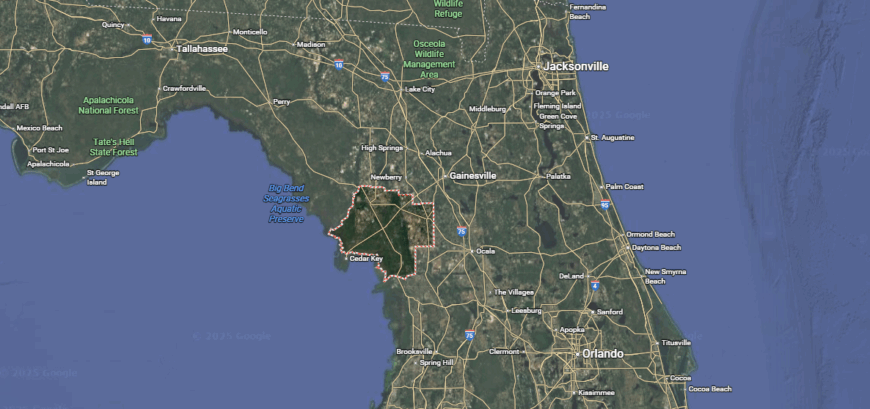
Levy County occupies a broad stretch of Florida’s Gulf Coast, with salt marshes, islands, and fishing villages marking its western edge. Inland, the landscape shifts to pine forests, farmland, and small towns spread across nearly 1,100 square miles.
Bronson serves as the county seat, while coastal communities such as Cedar Key and Yankeetown highlight Levy’s maritime history and connection to the Gulf. The county is also noted for its springs and nature preserves, balancing agriculture and forestry with tourism and outdoor recreation.
#17. Gadsden County (tie)
– Life expectancy: 74.1 years
— 4.4 years lower than the state average

About
Gadsden County, located in Florida’s Panhandle, carries a rich agricultural history, once known as the state’s leading tobacco producer. Quincy, the county seat, preserves much of this heritage with its historic courthouse square and Victorian-era homes that reflect a deep civic tradition. Nearby towns and rural communities maintain strong cultural roots, where farming and family life remain central.
The county’s landscape of rolling hills, fertile soil, and shaded roads supports both agriculture and outdoor recreation. Local festivals, church gatherings, and community events highlight a strong sense of identity, while residents continue to honor the balance between history, land, and connection that defines Gadsden County.
Where is Gadsden County?
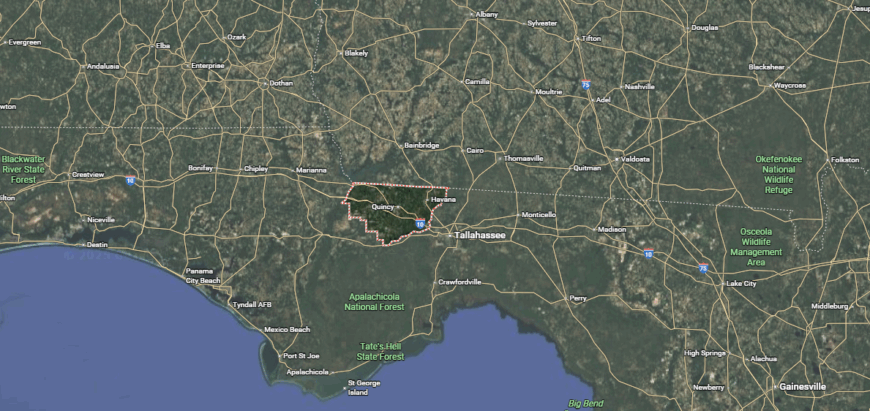
Gadsden County developed its identity around tobacco, a crop that once made it unique in Florida and shaped the lives of its communities for decades. That agricultural legacy still lingers, even as the county has shifted toward other forms of farming and small-scale industry.
Quincy anchors the area with its historic courthouse square, while towns like Havana and Chattahoochee reflect a mix of artistic revival and riverfront history. Set in the Panhandle just west of Tallahassee, Gadsden ties together rural traditions with its role as a link to the Georgia borderlands.
#16. Dixie County (tie)
– Life expectancy: 74.1 years
— 4.4 years lower than the state average

About
Dixie County, along Florida’s Big Bend coast, is shaped by its forests, rivers, and stretches of undeveloped shoreline. Cross City, the county seat, serves as the hub of civic and community life, while nearby towns reflect the county’s heritage of fishing, forestry, and rural traditions.
The Suwannee River and Gulf waters remain central, supporting both livelihood and recreation for residents. With its quiet pace, natural setting, and enduring ties to land and water, Dixie County embodies the character of a community rooted in simplicity and resilience.
Where is Dixie County?

Dixie County is part of Florida’s Big Bend region, where the Gulf of Mexico meets broad marshes and low-lying coastal flats. The county is largely rural, with wide forests inland and access to waterways that define much of its western edge.
Cross City is the county seat and main center of daily life, while Horseshoe Beach and Suwannee serve as small fishing and boating communities along the Gulf. Farming, timber, and coastal heritage continue to shape Dixie’s character.
#15. Okeechobee County (tie)
– Life expectancy: 73.9 years
— 4.6 years lower than the state average
You may also like: How much manufacturers in Florida spend on equipment

About
Okeechobee County centers around its namesake lake, the largest in Florida, which has long shaped the county’s culture and economy. The city of Okeechobee serves as the heart of community life, with traditions tied to ranching, farming, and the water.
Rodeos, fishing, and agricultural fairs highlight the strong bond between residents and the land that sustains them. With open prairies, working farms, and a lifestyle rooted in both heritage and resourcefulness, Okeechobee County continues to reflect the spirit of rural Florida.
Where is Okeechobee County?

Okeechobee County lies in south-central Florida, surrounding the northern shore of Lake Okeechobee, the state’s largest freshwater lake. Much of the county’s identity is tied to this body of water, which influences its landscape, recreation, and agriculture.
Okeechobee, the county seat, sits along the lake’s edge and serves as the primary hub for government, commerce, and schools. The area is known for cattle ranching, farming, and freshwater fishing, while the lake itself provides both economic activity and a central gathering point for the county.
#14. Gulf County (tie)
– Life expectancy: 73.9 years
— 4.6 years lower than the state average

About
Gulf County stretches from sandy Gulf beaches to quiet inland forests, giving it a character that balances coastal life with rural tradition. Port St. Joe anchors the county with its historic downtown and ties to industry, while nearby towns like Wewahitchka are known for tupelo honey and small-town heritage.
Residents share a strong connection to the outdoors, whether through fishing, scalloping, or community events tied to the seasons. Gulf County’s identity rests in this blend of natural resources, close community ties, and a lifestyle shaped by both water and land.
Where is Gulf County?
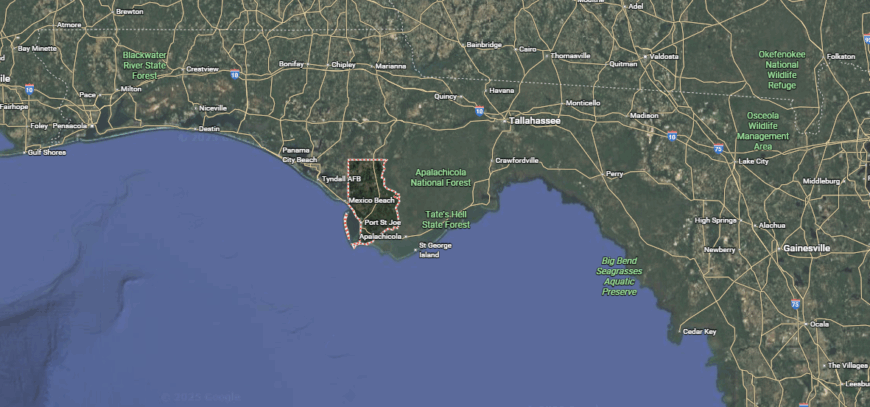
Gulf County sits in Florida’s Panhandle, stretching from the white-sand beaches of the Gulf of Mexico to the marshes and woodlands inland. The county is divided almost in two by the Intracoastal Waterway, which runs across its length and shapes local travel and commerce.
Port St. Joe is the county seat and the main center for business and government, while Wewahitchka, further north, is known for its tupelo honey and rural character. With a mix of coastal tourism, small-town life, and natural areas, Gulf County maintains a balance between its waterfront economy and inland traditions.
#13. Suwannee County
– Life expectancy: 73.8 years
— 4.7 years lower than the state average

About
Suwannee County, in north Florida, is named for the famed Suwannee River that winds along its border and defines much of its identity. Live Oak, the county seat, serves as a hub of commerce, culture, and community traditions that tie residents together.
The county’s heritage is rooted in farming, forestry, and music, with festivals and gatherings celebrating both land and culture. With fertile soil, flowing springs, and a strong sense of connection, Suwannee County continues to reflect the enduring rhythm of rural Florida life.
Where is Suwannee County?
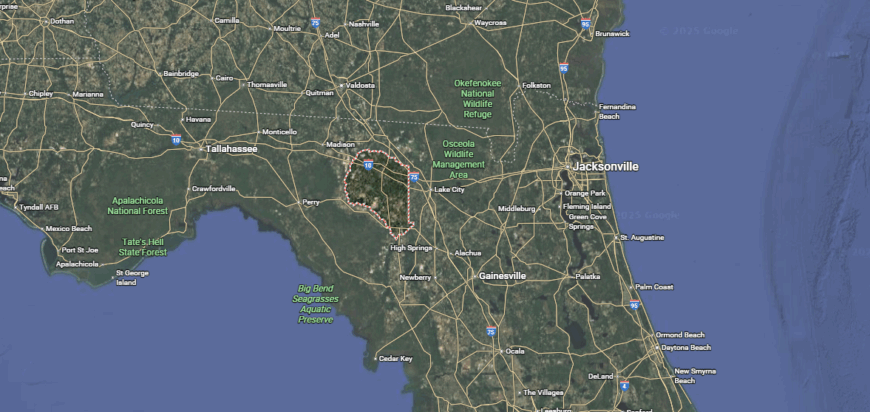
Suwannee County is named for the Suwannee River, which forms much of its northern, western, and southern borders. The county is inland, located in north Florida, and is characterized by rolling farmland, pine forests, and riverfront landscapes.
Live Oak serves as the county seat and is the largest community, functioning as the center for government, schools, and commerce. Smaller towns such as Branford and Wellborn reflect the county’s rural roots. With its springs, river access, and strong agricultural base, Suwannee County blends natural features with farming traditions.
#12. Liberty County
– Life expectancy: 73.7 years
— 4.8 years lower than the state average

About
Liberty County, one of Florida’s least populated, is surrounded by vast stretches of natural forest and rivers that shape both its setting and way of life. Bristol, the county seat, serves as the civic center, while much of the area remains defined by the Apalachicola National Forest and the Ochlockonee River.
The economy and culture are closely tied to timber, outdoor traditions, and a community spirit that thrives in small-town settings. With its quiet pace, abundant natural resources, and close-knit ties, Liberty County reflects the character of a place deeply connected to land and heritage.
Where is Liberty County?
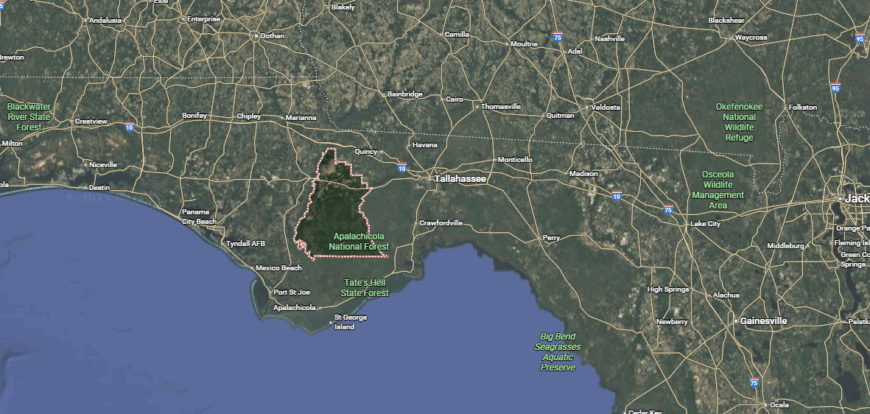
Liberty County is one of the least populated counties in Florida, set deep in the Panhandle and almost entirely covered by forest. Much of its land falls within the boundaries of the Apalachicola National Forest, making conservation and outdoor recreation central to its identity.
Bristol is the county seat and the only incorporated town, serving as the hub for schools and government. The rest of Liberty is made up of scattered rural communities, hunting grounds, and river access points, giving it a quiet, wilderness-dominated character.
#11. Taylor County
– Life expectancy: 73.5 years
— 5.0 years lower than the state average

About
Taylor County lies along Florida’s Big Bend coast, where pine forests and the Gulf of Mexico meet to shape both its economy and lifestyle. Perry, the county seat, anchors community life with traditions built around forestry, fishing, and small-town heritage.
Hunting, scalloping, and outdoor festivals highlight the county’s strong ties to land and water. With its balance of working forests, coastal culture, and close community bonds, Taylor County continues to carry forward the spirit of rural Florida.
Where is Taylor County?

Taylor County stretches along Florida’s Big Bend coast, with long stretches of marshland and Gulf shoreline defining its southern edge. Inland, pine forests and farmland dominate, covering much of the county’s 1,000 square miles.
Perry, the county seat, is the largest community and serves as the hub for commerce, schools, and government. The economy is tied to forestry, timber production, and coastal industries, while fishing villages and boat landings along the Gulf highlight Taylor County’s maritime side.
#10. Citrus County (tie)
– Life expectancy: 73.2 years
— 5.3 years lower than the state average
You may also like: Counties in Florida with more precipitation over the past year than average

About
Citrus County developed around its waterways, with the Crystal and Homosassa rivers long serving as lifelines for fishing, trade, and recreation. The county seat, Inverness, reflects a blend of historic charm and civic tradition, while coastal communities keep strong ties to the Gulf.
Manatees gathering in warm springs have become a signature of the region, drawing both visitors and pride from locals. Alongside its natural springs and protected lands, Citrus County sustains a lifestyle that balances outdoor living, cultural heritage, and steady community connection.
Where is Citrus County?
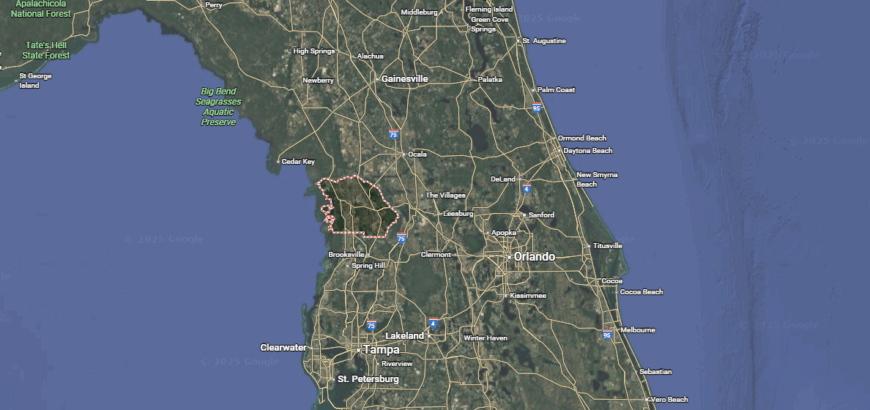
Citrus County lies along Florida’s west coast, where the Gulf of Mexico meets rivers, springs, and extensive coastal wetlands. The county is named for the citrus groves that once dominated the area, though today it is equally known for its natural preserves and waterways.
Inverness serves as the county seat, while Crystal River and Homosassa anchor the coastal side with their spring-fed rivers and manatee habitats. With a mix of retirement communities, tourism, and protected lands, Citrus County blends small-town life with a strong focus on its natural environment.
#9. Columbia County (tie)
– Life expectancy: 73.2 years
— 5.3 years lower than the state average

About
Columbia County, often called the “Gateway to Florida,” has been shaped by its crossroads location where railroads and highways link the Deep South to the peninsula. Lake City, the county seat, reflects this role with a blend of historic architecture, civic institutions, and a tradition of being a gathering place for surrounding communities.
The county’s rivers, springs, and forests support farming, forestry, and outdoor recreation, giving residents a steady connection to land and water. Annual festivals, school traditions, and local markets strengthen bonds, while Columbia County continues to balance its historic identity with steady growth and community pride.
Where is Columbia County?

Columbia County is located in north Florida, where major highways I-75 and I-10 intersect, making it a key crossroads for travel across the state. The county covers roughly 800 square miles of farmland, forest, and freshwater springs.
Lake City is the county seat and largest community, serving as the center of commerce, education, and government. Smaller towns and rural areas surround it, while natural features like the Ichetucknee Springs and Olustee Battlefield tie Columbia County to both recreation and history.
#8. Escambia County
– Life expectancy: 73.1 years
— 5.4 years lower than the state average

About
Escambia County, Florida’s westernmost, carries a long history shaped by its coastal location and centuries of cultural exchange. Pensacola, the county seat, is one of the oldest European-founded settlements in the United States, known for its historic forts, naval presence, and vibrant downtown.
The Gulf of Mexico and Escambia Bay support both economic life and recreation, from commercial fishing to beach tourism. With its blend of military heritage, maritime culture, and diverse communities, Escambia County reflects a unique place where history and coastal living meet.
Where is Escambia County?

Escambia County is the westernmost county in Florida, sharing a border with Alabama and stretching south to the Gulf of Mexico. It covers just over 660 square miles, with both inland pine forests and a busy coastal shoreline.
Pensacola is the county seat and largest city, long known for its naval air station, deepwater port, and historic downtown. Communities such as Century in the north and Perdido Key on the coast add contrast between rural life and beach destinations. Escambia’s economy blends military presence, shipping, tourism, and regional trade.
#7. Madison County
– Life expectancy: 73.0 years
— 5.5 years lower than the state average

About
Madison County, in north Florida, is marked by rolling farmland, pine forests, and a history rooted in agriculture. The city of Madison, serving as the county seat, preserves this legacy with its historic courthouse square and small-town traditions that continue to anchor community life.
Cultural events, church gatherings, and agricultural fairs bring neighbors together, reinforcing strong local ties. With its blend of history, working lands, and a steady rural pace, Madison County reflects the enduring spirit of Florida’s small-town communities.
Where is Madison County?

Madison County sits in north Florida along the Georgia border, a largely rural area shaped by farmland, timberland, and small towns. Covering about 700 square miles, it lies between the Suwannee and Aucilla Rivers, with rolling hills and open pastures defining its landscape.
Madison, the county seat, anchors the region with its historic courthouse square and role as the hub for schools and government. Smaller communities such as Greenville and Lee mark the county’s quieter corners. Known for its agricultural base and easy access to I-10, Madison County links Florida’s Panhandle to the rest of north Florida while maintaining its small-town character.
#6. Hamilton County
– Life expectancy: 72.7 years
— 5.8 years lower than the state average

About
Hamilton County, set along Florida’s northern border, is defined by its rivers—the Suwannee, Alapaha, and Withlacoochee—which shape both its geography and way of life. Jasper, the county seat, holds a legacy of historic buildings and traditions that continue to serve as the cultural center of the area.
The county’s rural economy has long been tied to farming, forestry, and transportation, with natural springs and waterways adding to its character. Community gatherings, outdoor recreation, and a strong sense of heritage keep Hamilton County closely connected to both its land and its people.
Where is Hamilton County?
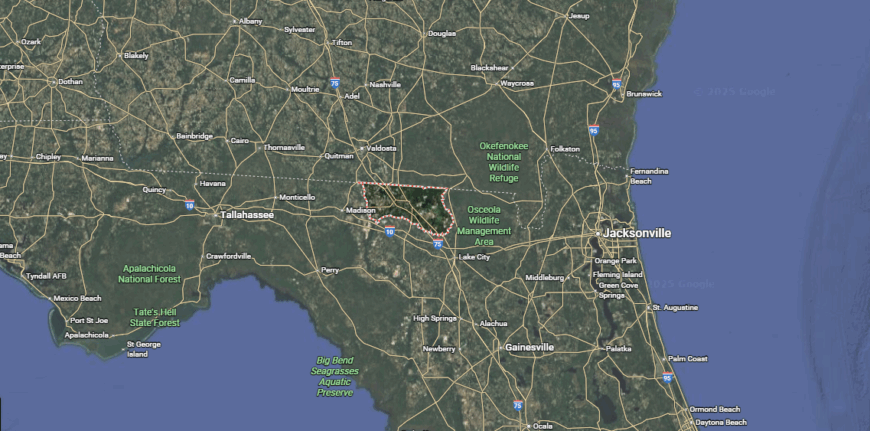
Hamilton County is tucked into Florida’s northern border, surrounded by Georgia to the north and the Suwannee and Withlacoochee Rivers along its edges. Its location at the crossroads of I-75 and I-10 gives it strong connections to the rest of north Florida and neighboring states.
Jasper serves as the county seat, with White Springs and Jennings as its other main towns. The area is noted for phosphate mining in its past, while today it is more closely tied to agriculture, riverfront recreation, and historic springs that highlight Hamilton’s blend of rural and natural character.
#5. Jackson County
– Life expectancy: 72.1 years
— 6.4 years lower than the state average
You may also like: The best beach towns in Florida

About
Jackson County, in Florida’s Panhandle, carries a deep agricultural heritage with fertile fields that have long supported farming and ranching. Marianna, the county seat, reflects this history with its historic district, civic landmarks, and role as a center of education and commerce.
Caves, springs, and rivers add a distinctive natural backdrop, offering recreation and shaping the county’s identity beyond its farmland. With its mix of history, natural features, and enduring rural traditions, Jackson County represents both the resilience and richness of north Florida life.
Where is Jackson County?
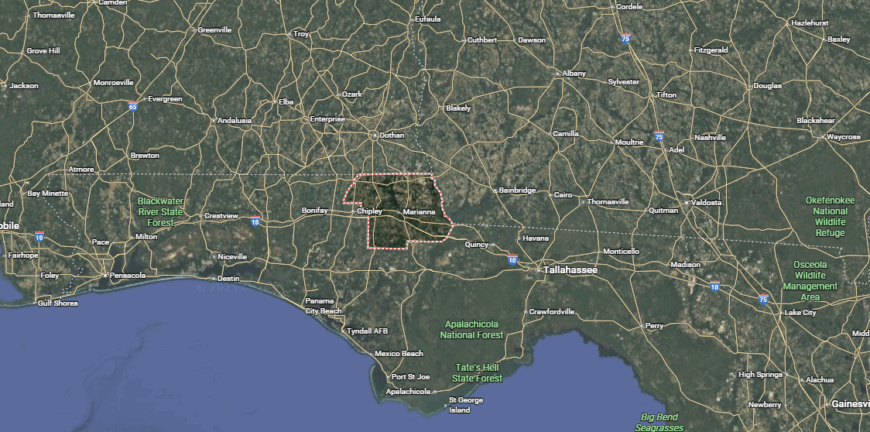
Jackson County is part of Florida’s Panhandle, bordering both Alabama and Georgia and covering more than 900 square miles of farmland, rivers, and rolling hills. Positioned inland, it is one of the few counties in the state without direct access to the Gulf or Atlantic, giving it a distinctly agricultural identity.
Marianna, the county seat, is known for its historic downtown and proximity to Florida Caverns State Park, the only state park with dry caves open to the public. Other communities such as Graceville, Sneads, and Cottondale reflect the county’s rural character. With agriculture, education, and natural landmarks at its core, Jackson County ties together history, farming, and outdoor recreation.
#4. Washington County
– Life expectancy: 71.8 years
— 6.7 years lower than the state average

About
Washington County, located in Florida’s Panhandle, is defined by its pine forests, farmland, and freshwater springs that have long supported settlement and industry. Chipley, the county seat, reflects the area’s heritage with historic neighborhoods and serves as a hub for local schools, commerce, and civic life.
The county’s identity is tied to both its natural resources and its small-town traditions, where community events and outdoor recreation remain central. With its balance of rural landscapes, history, and close-knit ties, Washington County continues to embody the steady character of north Florida.
Where is Washington County?

Washington County lies in Florida’s Panhandle, inland from the Gulf Coast and surrounded by forested hills, springs, and farmland. Covering just over 600 square miles, it is known more for its rural character than for large urban centers.
Chipley serves as the county seat and is the largest town, located near the crossroads of major highways including I-10. Smaller communities like Vernon and Wausau add to the county’s patchwork of rural settlements. With agriculture, timber, and outdoor recreation shaping daily life, Washington County maintains a quiet landscape tied closely to its natural resources.
#3. Holmes County
– Life expectancy: 71.7 years
— 6.8 years lower than the state average

About
Holmes County, tucked into Florida’s Panhandle, is known for its rolling hills, farmland, and quiet rural communities. Bonifay, the county seat, anchors local life with schools, churches, and traditions that reflect the county’s long agricultural roots.
The area is closely tied to its land, where farming and forestry continue to guide the local economy. Festivals, family gatherings, and outdoor activities highlight a strong sense of community, making Holmes County a place where heritage and daily life remain deeply connected.
Where is Holmes County?
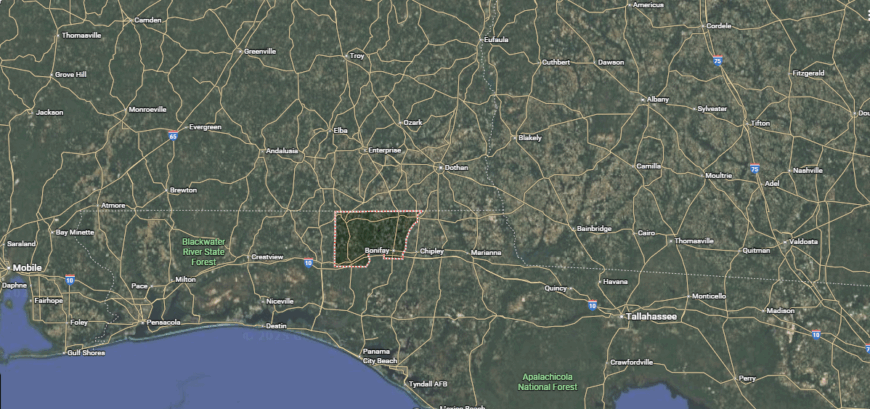
Holmes County sits along Florida’s northern border with Alabama, occupying a little more than 480 square miles of farmland, pine woods, and small towns. The Choctawhatchee River flows along its eastern side, giving the county both fertile bottomlands and access to river recreation.
Bonifay is the county seat and the center of government and commerce, while smaller communities like Ponce de Leon and Esto reflect its rural makeup. Agriculture and forestry remain central to Holmes County, with springs and state parks adding to its natural appeal.
#2. Putnam County
– Life expectancy: 71.5 years
— 7.0 years lower than the state average

About
Putnam County, situated in northeast Florida, is shaped by the St. Johns River, which runs through its heart and has guided both settlement and trade for generations. Palatka, the county seat, grew as a river port and today reflects a mix of historic architecture, civic landmarks, and cultural traditions.
The county’s economy and lifestyle are tied to forestry, agriculture, and outdoor recreation, with abundant lakes and waterways offering year-round activity. From river festivals to small-town gatherings, Putnam County continues to balance its historic identity with the steady rhythm of community life.
Where is Putnam County?
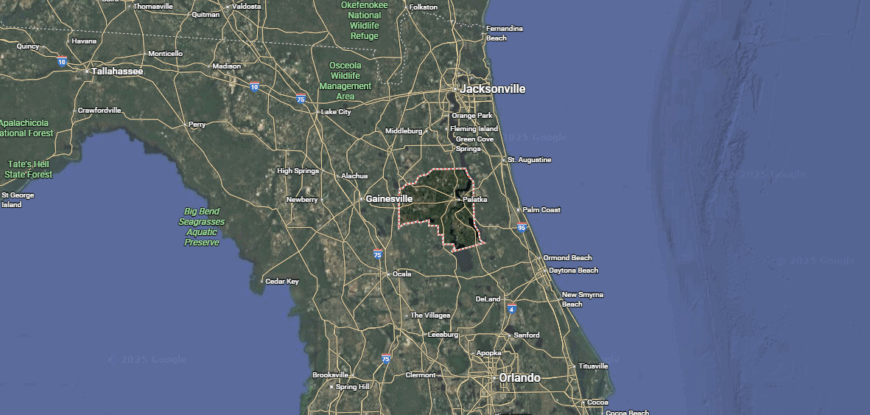
Putnam County is located in northeast Florida, stretching between the St. Johns River on its western edge and the forests and lakes that cover much of its interior. It spans just over 800 square miles, with waterways and wetlands forming a major part of its geography.
Palatka serves as the county seat and largest city, positioned along the St. Johns River and historically known as a steamboat and rail hub. Smaller communities such as Crescent City and Interlachen add to the county’s rural character. Agriculture, forestry, and riverfront recreation continue to shape Putnam County’s identity.
#1. Union County
– Life expectancy: 67.4 years
— 11.1 years lower than the state average

About
Union County, one of Florida’s smallest in land area, is marked by its close-knit communities and strong rural traditions. Lake Butler, the county seat, serves as the center of civic life, with schools, churches, and local institutions anchoring daily activities.
Farming, forestry, and public service have long supported the local economy, while community gatherings and county events strengthen social ties. With its modest size and strong sense of identity, Union County reflects a way of life built on connection, resilience, and shared heritage.
Where is Union County?
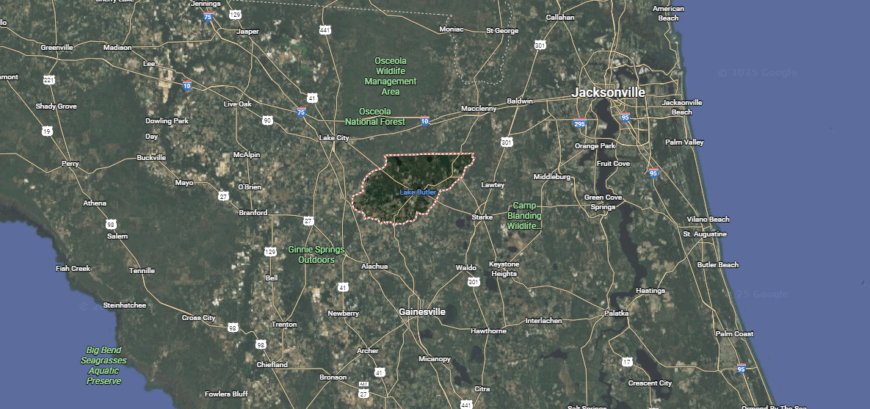
Union County is the smallest county in Florida by land area, covering less than 250 square miles in the north-central part of the state. Despite its size, it plays a significant role regionally through agriculture and state correctional institutions.
Lake Butler is the county seat and main community, situated near the center of the county. Surrounding it are scattered farms, pine forests, and lakes that give Union a largely rural setting. Its compact size and close-knit towns make it distinct among Florida’s counties.
This story features data reporting by Karim Noorani, writing by Kiersten Hickman, and is part of a series utilizing data automation across 49 states.
By Stacker

